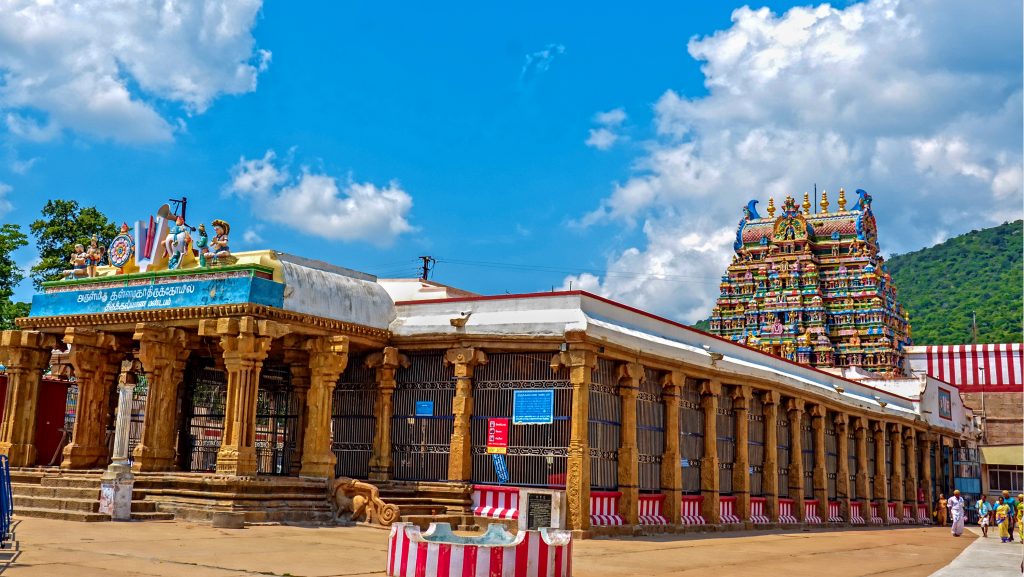Koodal Azhagar Temple in Madurai, a city in the South Indian state of Tamil Nadu, is dedicated to the Hindu god Vishnu. Constructed in the Dravidian style of architecture, the temple is glorified in the Divya Prabandha, the early medieval Tamil canon of the Azhwar saints from the 6th–9th centuries AD. It is one of the 108 Divyadesam dedicated to Vishnu, who is worshipped as Koodal Azhagar and his consort Lakshmi as Mathuravalli.
A granite wall surrounds the temple, enclosing all its shrines. The temple has a five-tiered rajagopuram, the gateway tower. The temple is originally believed to be built by the Pandyas, with later additions by the Vijayanagar and Madurai Nayak kings who commissioned pillared halls and major shrines of the temple during the 16th century.
Koodal Azhagar is believed to have appeared to slay the demon Somuka who abducted the four Vedas. The temple follows Thenkalai tradition of worship. Four daily rituals and three yearly festivals are held at the temple, of which the fourteen-day annual Brahmotsavam during the Tamil month of Vaikasi (May – June) being the most prominent. The temple is maintained and administered by the Hindu Religious and Endowment Board of the Government of Tamil Nadu.


The inscriptions in the temple refer the presiding deity as Koodal Azhagiya Perumal. There are inscriptions in the temple indicating generous gifts and endowments in the form of land, houses and gold to maintain and administer the temple. An inscription from the 8th century indicates the donation of granite stones for the construction of Ardha Mandapa. The temple was expanded during the rule of Madurai Nayaks in the 16th century. The Dwajasthambam madap (flag staff) and mandap before the Hema Pushkarani were constructed by the Nayaks. The temple was renovated by Alagappa Chettiar in 1920.
Koodal Azhagar temple covers an area of about 2 acres (0.81 hectares) and has a five-tiered gopuram (gateway tower) raising to a height of 125 ft (38 m). The temple in enclosed in a rectangular enclosure with huge granite walls. The central shrine has an elevated structure and houses the images of the presiding deity, Koodal Azhagar, in three forms, namely sitting, standing and reclining postures. The image is made of granite is sported in sitting posture and 6 ft (1.8 m) tall. The images of Sridevi and Bhudevi are present in either sides of Koodal Azhagar. The festival deity is named Vyuga Sundararajar and the image is 4 ft (1.2 m) tall made of panchaloha. The vimana, the shrine over the sanctum is Ashtanga in architecture, which has eight parts, namely, Adhistana (base), three Padas(struct), Prashthana (limb), Griva(leading struct), Shikara (cylindrical holder) and Stupi (top portion). The outer parts of the vimana has stucco images of sages, Dasavatara, Bhuvaraha, Lakshmi Narasimha, Lakshmi Narayana and Narayanamoorthy. The vimana is believed to be the work of Vishwakarma, the divine architect. The shadow of the vimana does not fall on the ground. The Ashtanga Vimana is found in Mannar Koil Ambasamudram Uthiramerur, Thirukoshtiyur and Cheranmadevi temples. The inner walls of the sanctum has paintings of Ashtadikpalagas.
The shrine of the consort of Koodal Azhagar, Mathuravalli, is located to the south of the main shrine. There are smaller shrines of Lakshmi Narasimha, Rama, Lakshmi Narayana and Krishna located close to the sanctum. The shrines of Andal, Narasimha and Manavala Mamunigal are found in separate shrines around the first precinct. The shrine of Andal has painting depicting puranic stories and inscriptions detailing devotional literature. The shrines of Garuda, Anjaneya, Ramanuja, Vedanta Desika and Azhwars are found in the second precinct. The pillars in the halls leading to the sanctum have small sculptures. The temple has Navagrahas, the nine planetary deities, in the second precinct. The second floor has a shrine dedicated to Suryanarayana standing along with Devis. The Teppakulam, the temple tank, is located outside the temple premises. It has a centre hall made of granite
The temple follows the traditions of the Thenkalai sect of Vaishnavite tradition and follows Vaikasana aagama. In modern times, the temple priests perform the pooja (rituals) during festivals and on a daily basis. As at other Vishnu temples of Tamil Nadu, the priests belong to the Vaishnavaite community, a Brahmin sub-caste. The temple rituals are performed six times a day: Kalasanthi at 8:00 a.m., Uchikalam at 12:00 p.m., Sayarakshai at 5:00 p.m., and Aravanai Pooja at 6:00 p.m. Each ritual has three steps: alangaram (decoration), neivethanam (food offering) and deepa aradanai (waving of lamps) for both Koodal Azhagar and Mathuravalli. During the last step of worship, nagaswaram (pipe instrument) and tavil (percussion instrument) are played, religious instructions in the Vedas (sacred text) are recited by priests, and worshippers prostrate themselves in front of the temple mast. There are weekly, monthly and fortnightly rituals performed in the temple.
The fourteen day annual Brahmotsavam during the Tamil month of Vaikasi (May – June) is the most prominent festival of the temple. The festive images of the temple are brought in chariot round the streets of the temple in various mounts during all the fourteen days
